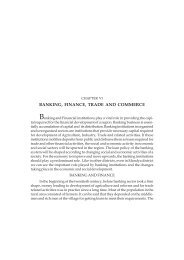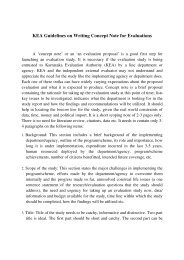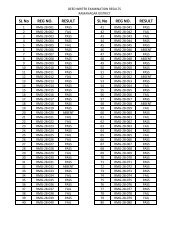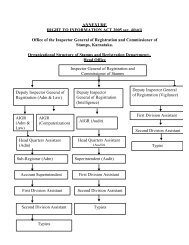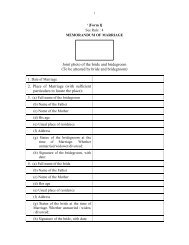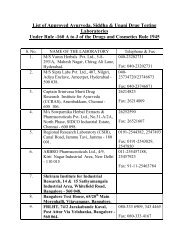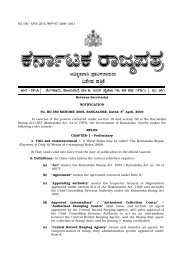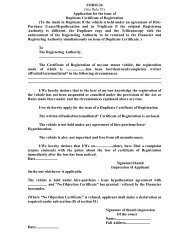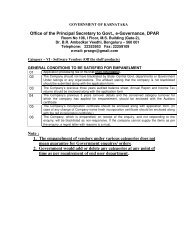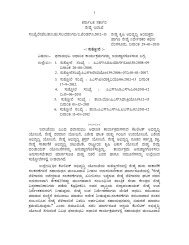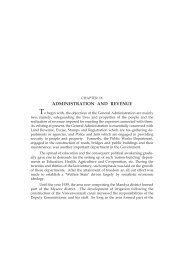Chapter XIII CULTURE - Government of Karnataka
Chapter XIII CULTURE - Government of Karnataka
Chapter XIII CULTURE - Government of Karnataka
You also want an ePaper? Increase the reach of your titles
YUMPU automatically turns print PDFs into web optimized ePapers that Google loves.
Culture 517<br />
Gudigar (1998), K. Shamacharya (1999) and M. Parameshwaracharya (2000),<br />
Dhananjaya Shilpi (2001), N.K.Mruthuanjayachar (2002), R.Kalachar (2003),<br />
K. Kashinath (2004), C. Siddalingaiah (2005), B.N. Channappacharya (2006)<br />
Malloja Bheemarao (2007) are awarded.<br />
Music in <strong>Karnataka</strong><br />
Indian classical music consists <strong>of</strong> two systems called Hindustani and<br />
Karnatak. Interestingly both these systems are prevalent in <strong>Karnataka</strong>. The<br />
Tungabhadra river more or less divides the domaine <strong>of</strong> these two in this<br />
state. The word ‘Karnatak’ in the context <strong>of</strong> music denotes a system <strong>of</strong> music<br />
prevailing in all the four states <strong>of</strong> the South India, i.e. <strong>Karnataka</strong>. Andhra<br />
Pradesh, Tamilnadu and Kerala, in the evolution <strong>of</strong> music, the role <strong>of</strong> <strong>Karnataka</strong><br />
has been very significant.<br />
Music, like literature and other creative arts, has been cultivated in<br />
<strong>Karnataka</strong> from ancient times. It was an indispensable part <strong>of</strong> the social<br />
and religious life <strong>of</strong> the people. Texts on music generally mention ancient<br />
theoriticians but not the performers who gave shape to these musical ideas.<br />
Bharata’s ‘Natya Shastra,’ perhaps the oldest treatise on the subject seems<br />
to have been known in <strong>Karnataka</strong> from early times. The most notable work is<br />
Matanga’s ‘Brihaddeshi. This work deals elaborately with the science <strong>of</strong> music<br />
<strong>of</strong> the folk songs <strong>of</strong> his time. Matanga was the first to use the word ‘raga’ for the<br />
melodies that were current in his time and this probably laid the foundation<br />
for the raga system <strong>of</strong> the present day music. Sharngadeva who was patronised<br />
by the Yadava (Sevuna) king <strong>of</strong> Devagiri, has given a total number <strong>of</strong> 26 ‘ragas’<br />
in his work, ‘Sangeetharatnakara’. Between the 11th and 17th Centuries<br />
only 32 ragas were in use and this is evident from a Vachana <strong>of</strong> Basavanna.<br />
Venkatamakhi (1660 A.D.) formulated his scheme <strong>of</strong> 72 melakartas and the<br />
classification <strong>of</strong> ragas was completed by him.<br />
A large number <strong>of</strong> theoritical works on music<br />
and dance were written by authors <strong>of</strong> <strong>Karnataka</strong><br />
origin. The prominent were ‘Abhilashitartha<br />
Chintanmani’ also called the ‘Rajamanasollasa’,<br />
‘Bharata Bhashya’, ‘Sangita Sudhakara’ written<br />
by Haripala, ‘Sangita Chudamani,’ Vidyaranya’s<br />
‘Sangita Sara’, ‘Bharatasara Sangraha’, ‘Viveka<br />
Chudamani’, ‘Sangita Suryodaya’, ‘Tala Deepika’,<br />
‘Sangita Sudha,’ ‘Chatrudandi Prakashika,’<br />
‘Sadraga Chandrodaya.’ ‘Ragamanjari,’ and<br />
‘Nartana Nirnaya,’ (these three by Pundalika<br />
Vithala), ‘Shivatatva Ratnakara,’ ‘Geetagopala,’<br />
‘Sritattvanidhi.’ ‘Shruti Siddanta,’ etc.<br />
An abundant variety <strong>of</strong> instruments were<br />
in use in <strong>Karnataka</strong>. The Kannada poets were<br />
well aware <strong>of</strong> the classical four fold divisions <strong>of</strong><br />
musical instruments into string, wind, percussion<br />
A bracket figure at Belur



